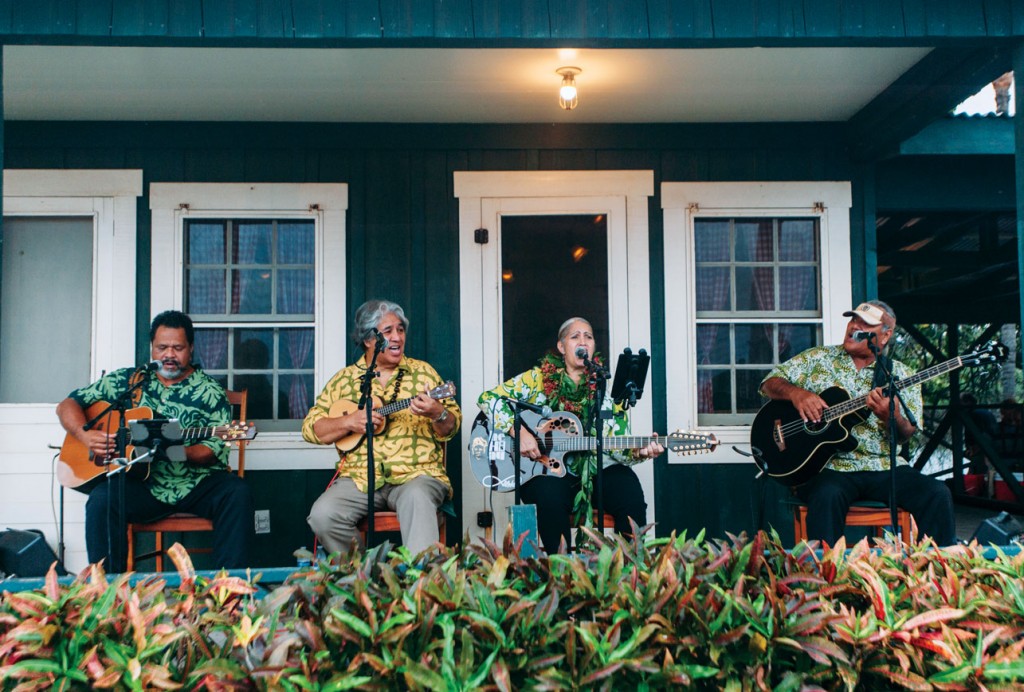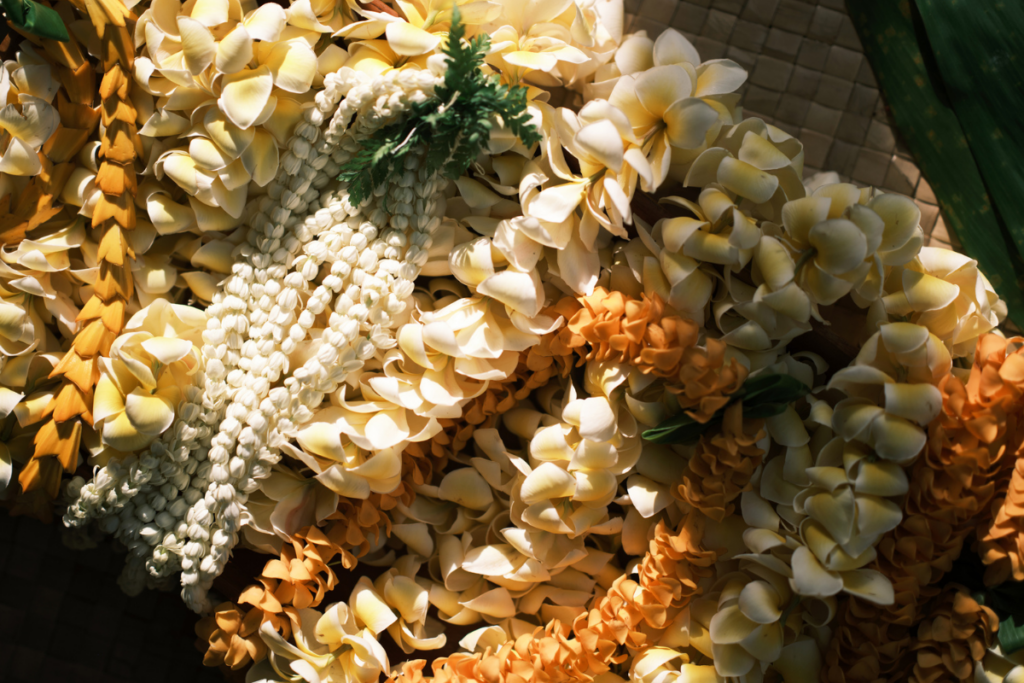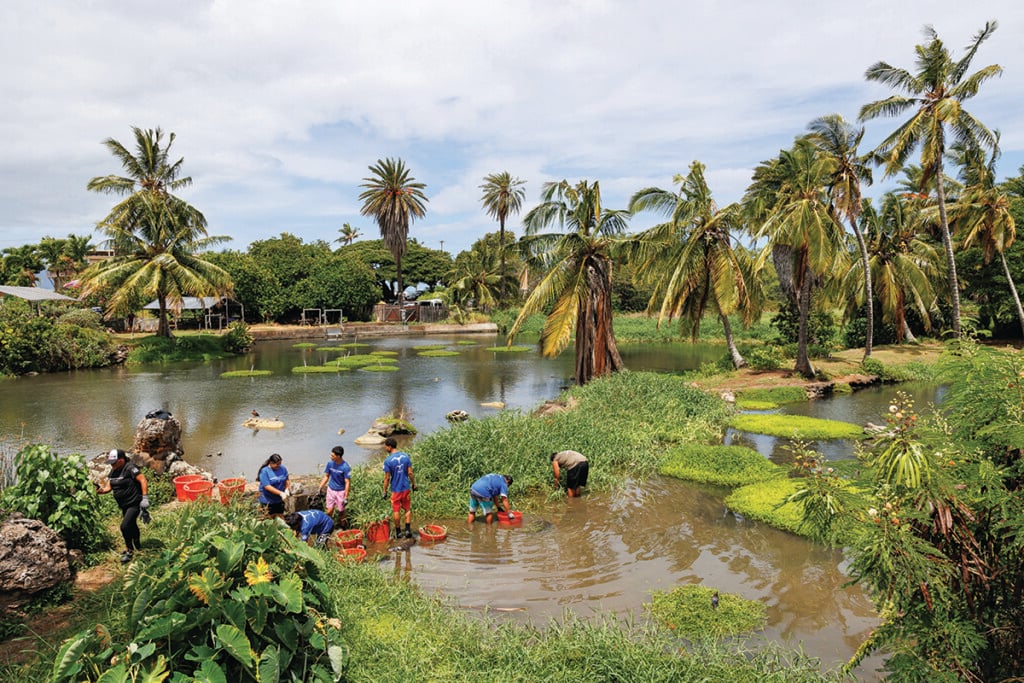Twilight at Kalahuipuaa: Live music and talk story gathering at Mauna Lani Bay Hotel
Next to Keawaiki Bay on Hawaii Island, a group of friends play music, tell stories, sing and dance well into the night.

Beneath the light of the full Big Island moon, a magical string of moments transpires: The air fills with mele (songs) and laughter over a kanikapila session, where all are welcome.
It’s the kind of tropical ambiance many young and old yearn to replicate—a Hawaiian night that shines a light on the past.
Thanks to Danny “Kaniela” Akaka, these nights exist. Twilight at Kalahuipuaa, a monthly event Akaka helped start as the cultural historian of the Mauna Lani Bay Hotel, has resurrected age-old gatherings fronting the historic Kalahuipuaa fishponds adjacent to the resort in North Kona. The event will celebrate 20 years of regular monthly gatherings this September.

Photo: Megan Spelman
“I grew up on Waikiki Beach, and I would come back to Kona to escape,” Akaka tells me as we sit in creaking rocking chairs inside the homey Eva Parker Woods Cottage, a replica of the original that once stood nearby. His first visit to Kalahuipuaa was in the 1970s, as a student with the University of Hawaii. “Before coming here, I didn’t know a place like this still existed—it was like stepping back through a window of time and being back in Old Hawaii.”
He remembers fondly of not just one but a series of impromptu shindigs held by the families that lived here—the Browns, the Ruddles and the Kihes—in the long-gone cluster of cottages that lined the remote shores fronting the Kalahuipuaa historic fishponds, of which they were caretakers. Francis Ii Brown, the renowned Hawaiian golf champion from a prominent alii (chief’s) family, often had interesting people over, including Duke Kahanamoku, John Wayne, Bing Crosby and Bob Hope.

Photo: Megan Spelman
Tonight, the crowd at Kalahuipuaa is a true blend of visitors and locals, awaiting the promise of a magical melange of storytelling and music fulfilled. I make my way to the rows of white chairs lining the lawn and watch elderly ladies fuss over one another, offering lei and talking of their families. The man seated next to me, who’s been visiting Kalahuipuaa for decades, leans over to say Akaka’s palaka-patterned shirt is just what Francis Ii Brown would have worn on a night like tonight.
Even then, the evening events were timed with the full moon. “It’s safe then,” Akaka said. He means it literally—with all of the extra light from the moon illuminating unpaved walkways between the hotel and the cottage—but, I think also of something else Akaka had shared: Stories of water spirits in the pond and mysterious chanting around the old fishponds.
When Akaka was offered the cultural historian position with the resort in the late 1990s, it was as if he had been magnetically pulled back to the landscape. He set about creating an event for hotel guests that evoked the area’s history and atmosphere—a hybrid of the intimate “talk story” jam sessions of the 1970s he vividly remembers, and the lively social gatherings hosted by Ii Brown in the mid-20th century.

Photo: Megan Spelman
“We spoke in Hawaiian and would share old stories of honu (turtle), mano (sharks) … and of the runners that would race the fish back alive from the maka koa (fishing grounds) here, all the way to Hilo,” Akaka said. “It was magical. Throughout my life, I always made a point of coming back. It was my way of coming back to the past.”
At Twilight at Kalahuipuaa, the night unfolds with an unscheduled, free flow of stories, music, socializing and hula. The gathering features special guests personally invited by Akaka. Past performers have included ukulele great Jake Shimabukuro, paniolo (Hawaiian cowboys) from Parker Ranch, various kumu hula (hula masters) and kupuna (elders). Adding to the gathering’s impromptu nature, their appearances are never scripted or announced in advance.
This evening, Akaka brings out special guest Darlene Ahuna, famed Hawaiian vocalist and multiple Na Hoku Hanohano award winner, and the crowd applauds approvingly. She is accompanied by her Big Island friends Joe Camacho on ukulele, Charlie Mahi on bass and Victor Chock on slack-key guitar. They sit on the lanai (porch) in a row of chairs under swinging lights.
Looking around, Ahuna seems surprised by the large group that has gathered—perhaps 300 people—and gives a shout out to the families enjoying picnics on the back lawn. Her clear voice cuts the air in a rendition of the old Hawaiian song, “Sweet Emalia.” The event regulars, mostly area residents who cluster in conversation to the right of the lanai, sing along.
I can see the interest in guests’ eyes as Ahuna then talks about how she met her bandmates, introducing each of the players’ personalities through song and letting them star with their instruments on a track meaningful to them. Audience members leave their seats to dance, unabashedly and barefoot on the grass directly fronting the audience. At one point, even Camacho sets down his instrument and dances a sensual hula to an innuendo-filled Hawaiian song. The crowd roars.

The horizon melts from golden hues into deep blue, the songs get livelier and Ahuna shouts: “We’re waking up the kupuna over here!” Right on cue, rare Kona lightning rips through the sky in fierce flashes.
As Ahuna continues to the next song, a man rises from the crowd and introduces himself shyly to Akaka, who’s seated off to the side of the musicians in a rocking chair. When the music concludes, Akaka shares what he learned: The man’s name is Charles Dahlberg and he’s the grandson of Helen Desha Beamer. She was a famous composer of Hawaiian-language songs, whose body of work includes “Ke Keawaiki,” a song immortalizing Francis Ii Brown and his home at Kalahuipuaa, and “Kawohikukapulani,” written for Dahlberg’s mother’s wedding.
The musicians, dumbstruck by the audience member’s revelation, pick up their instruments and perform “Kawohikukapulani” effortlessly and soulfully. Akaka’s wife, Anna, steps down from the lanai to dance an elegant, sweeping hula in the grass. Fat raindrops start to fall from the sky, but the audience is glued to their chairs, transfixed. Charles Dahlberg sings along with tears in his eyes.

“In my hope it would never end,” Akaka told me wistfully of the event. “It will continue beyond our lifetimes and will be here in some form. Uncle Francis will be here, too, with a drink in his hand and a big smile, surrounded by friends and people he doesn’t know.”
Twilight at Kalahuipuaa, 5:30–8:30 p.m. on the Saturday closest to the full moon. For dates, visit maunalani.com.


